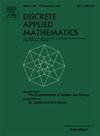The Gowers U3 norm of one family of cubic power permutations
IF 1
3区 数学
Q3 MATHEMATICS, APPLIED
引用次数: 0
Abstract
The Gowers uniformity norm has emerged as a significant metric in the evaluation of Boolean functions employed in symmetric-key encryptions, particularly in assessing their resilience against low degree approximation attacks. Beyond cryptography, this norm plays a pivotal role in theoretical computer science, including pseudorandomness and property testing of Boolean functions. However, the determination of the Gowers norm for for general Boolean functions presents substantial computational and theoretical challenges. Recently, the relationship between the Gowers uniformity norm and the higher-order differential spectrum of Boolean functions has been derived. Furthermore, the fact that the Gowers uniformity norm of a power permutation can be determined by the Gowers uniformity norm of its any component function. In this paper, we focus on determining the Gowers norm of one family of power permutations, thereby assessing their resistance to quadratic approximation attacks. The family contains five classes of power permutations, which are with even , with and , with , with even , and with odd . We establish the second-order differential spectrum of these power permutations, by determining the number of solutions of certain linearized polynomials. Thus, we are able to derive the Gowers norms of these power permutations. At last we present a comparison of the Gowers norms of these power permutations. Our analysis yielded a significant finding that the power permutation with exhibits a better resistance against quadratic approximation attacks than the other four classes of power permutations.
求助全文
约1分钟内获得全文
求助全文
来源期刊

Discrete Applied Mathematics
数学-应用数学
CiteScore
2.30
自引率
9.10%
发文量
422
审稿时长
4.5 months
期刊介绍:
The aim of Discrete Applied Mathematics is to bring together research papers in different areas of algorithmic and applicable discrete mathematics as well as applications of combinatorial mathematics to informatics and various areas of science and technology. Contributions presented to the journal can be research papers, short notes, surveys, and possibly research problems. The "Communications" section will be devoted to the fastest possible publication of recent research results that are checked and recommended for publication by a member of the Editorial Board. The journal will also publish a limited number of book announcements as well as proceedings of conferences. These proceedings will be fully refereed and adhere to the normal standards of the journal.
Potential authors are advised to view the journal and the open calls-for-papers of special issues before submitting their manuscripts. Only high-quality, original work that is within the scope of the journal or the targeted special issue will be considered.
 求助内容:
求助内容: 应助结果提醒方式:
应助结果提醒方式:


